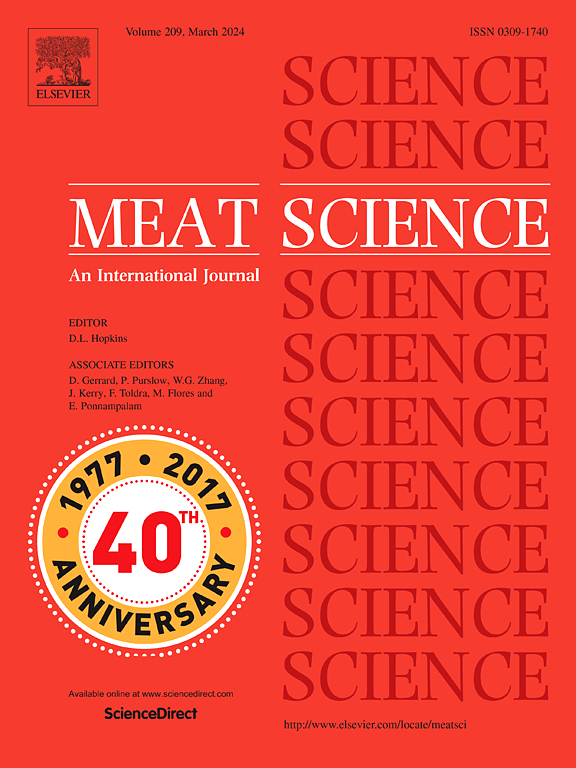Dry-ageing impacts on meat quality, oxidative stability, and release of free amino acids in striploins from dairy crossbred yearling and 2-year-old steers
IF 7.1
1区 农林科学
Q1 Agricultural and Biological Sciences
引用次数: 0
Abstract
This study determined the impacts of dry-ageing on meat quality, oxidative stability, and release of free amino acids (FAAs) in striploins from dairy-crossbred yearlings and 2-year-old steers (n = 12 each group) over 21 days of in-bag dry-ageing. Dry-ageing increased weight losses, with higher % drying rates in yearling meat during dry-ageing, likely due to the smaller loin size and lower intramuscular fat content (P < 0.05). Yearling meat showed greater (P < 0.05) decreases in moisture content, but both meats reached similar moisture levels by day 21. pH values increased with dry-ageing with variations at different ageing times. Dry-ageing reduced a*, b*, and chroma while increasing L* and hue angles on day 21 (P < 0.05), likely due to dehydration and lipid oxidation (higher TBARS, P < 0.05) after 14 days, especially in yearling meat. The decreased levels (P < 0.05) of some monounsaturated fatty acids and conjugated linoleic acid cis-9, trans-11 were likely linked with lipid oxidation. Total levels of FAAs and essential amino acids increased significantly, especially within the first 7 days, with distinct patterns between the two meats. Dry-aged yearling meat contained more FAAs associated with sweat taste (e.g., glutamine and glycine) and fewer FAAs associated with bitter taste (e.g., phenylalanine and tyrosine). Carnosine levels varied and significantly increased after 21 days. Dry-ageing demonstrated distinct effects on dehydration, lipid oxidation, and release of FAAs in meat from yearlings compared with 2-year-old steers, which can be tailored to develop high-quality beef products with unique flavours.
干龄对一岁和两岁奶牛杂交阉牛的肉质、氧化稳定性和游离氨基酸释放的影响
本研究测定了在21天的袋中干龄化过程中,干龄化对奶牛杂交一岁牛和两岁阉牛(每组12头)的肉质、氧化稳定性和游离氨基酸(FAA)释放的影响。干燥老化增加了体重损失,一岁牛在干燥老化期间的干燥率较高,这可能是由于其腰部较小和肌肉内脂肪含量较低(P <0.05)。一岁肉的水分含量下降较多(P < 0.05),但到第 21 天时两种肉的水分含量相近。干制老化在第 21 天降低了 a*、b* 和色度,同时增加了 L* 和色调角(P < 0.05),这可能是由于 14 天后脱水和脂质氧化(TBARS 增加,P < 0.05),尤其是一岁羔羊肉。一些单不饱和脂肪酸和共轭亚油酸顺式-9、反式-11 水平的降低(P <0.05)可能与脂质氧化有关。FAAs和必需氨基酸的总含量显著增加,特别是在最初的7天内,两种肉类之间有明显的差异。干制一岁羔羊肉含有更多与汗味相关的 FAAs(如谷氨酰胺和甘氨酸),而与苦味相关的 FAAs(如苯丙氨酸和酪氨酸)较少。肌肽的含量各不相同,21 天后显著增加。与 2 岁的阉牛相比,干龄化对一岁阉牛肉的脱水、脂质氧化和 FAAs 的释放有明显的影响,可用于开发具有独特风味的优质牛肉产品。
本文章由计算机程序翻译,如有差异,请以英文原文为准。
求助全文
约1分钟内获得全文
求助全文
来源期刊

Meat Science
工程技术-食品科技
CiteScore
12.60
自引率
9.90%
发文量
282
审稿时长
60 days
期刊介绍:
The aim of Meat Science is to serve as a suitable platform for the dissemination of interdisciplinary and international knowledge on all factors influencing the properties of meat. While the journal primarily focuses on the flesh of mammals, contributions related to poultry will be considered if they enhance the overall understanding of the relationship between muscle nature and meat quality post mortem. Additionally, papers on large birds (e.g., emus, ostriches) as well as wild-captured mammals and crocodiles will be welcomed.
 求助内容:
求助内容: 应助结果提醒方式:
应助结果提醒方式:


